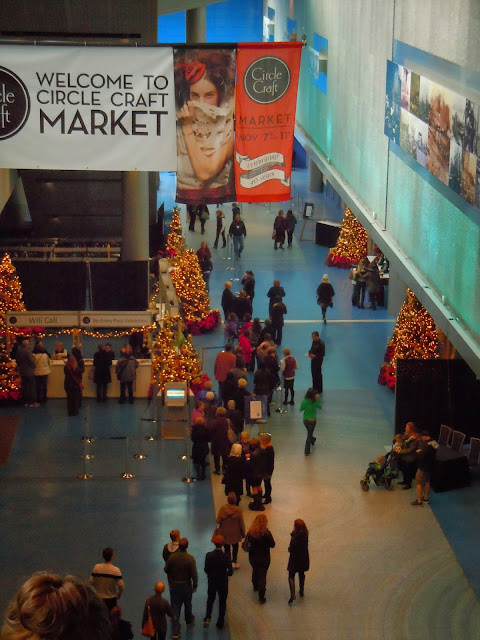I write this
as I sit on the bus on my way home from what has become (to my family’s dismay)
my ‘yearly’ trip down to “Circle Craft, Christmas Market”, in Vancouver.
CircleCraft Cooperative is a BC Artists cooperative that is dedicated to helping
artisans reach the community and be able to sell their goods in a professional
and inviting setting. It has grown enormously since its humble beginnings in 1972
and is now a driving force in the arts and crafts sector providing scholarships
and other resources. You can find their
product year round at their Granville Island shop. But every November 11
weekend, they put on one of their biggest events: their yearly Christmas
Market. And for me, this is number 3 – as
a spectator.
The first
time I went, I was dragged down by my friend M. M and I go back to
Fashion School days and we’ve been through lots of things together including
being roommates in Vancouver, and now having kids almost the same ages.
I say ‘dragged’
loosely because it really didn’t take much convincing. After all, it was a girl’s
weekend away with no kids! What’s not to like? And although she had shown me
some of the artists stuff online, I really had no idea of what to expect.
I still
remember getting off the Greyhound and taking the Sky train with our suitcases
in tow because we didn’t want to waste time unpacking where we were staying.
Instead we simply planned to ‘check’ our luggage in with the ‘parcel check’ at
the fair and spend the first evening there.
So as we stood on the escalator going down towards the Convention Centre,
it really hit me that this was a craft fair like I’d never seen before.
The next
few hours kind of flew by as M and I talked to exhibitors and admired every
detail of their work. What is really
different about this fair is the sheer caliber of talent and skill in the
products being offered. In order to be an exhibitor, you must be approved by a
panel, so no “Michael’s DIY” need apply. Every artwork here is an original and
many are one of a kind. Did I mention there are over 300 exhibitors? There are
painters, ceramic artists, woodwork and metal craftsmen, jewelry and of course,
my favourite: fashion.
Here’s the
sustainable bit about Circle Craft: all of the designers featured must bring product
that is hand crafted in order to be part of the show. So you’ll find a variety
of small scale designers from Toronto, Montreal, Vancouver and sometimes remote
areas in Victoria or Nelson. Their angle is: Made in Canada. But it doesn’t
stop there, many also incorporate recycled or environmentally friendly
materials, so they’ll use organic cottons or up-cycle something from vintage
clothing. There’s a lot of original silk-screening
and the weavers are in a whole different category! IT IS AWESOME.
I can’t
help but be inspired every time I go. These designers are making a go in a very
cutthroat industry by going against the grain. Choosing to make things in
Canada is choosing to remain small scale and unfortunately to have a higher
price point, which is –I know- not affordable to the masses. The thing to keep
in mind here is that their price point is closer to the ‘real’ cost of
producing clothing and if one values quality and originality, then this is the
place to buy.


















